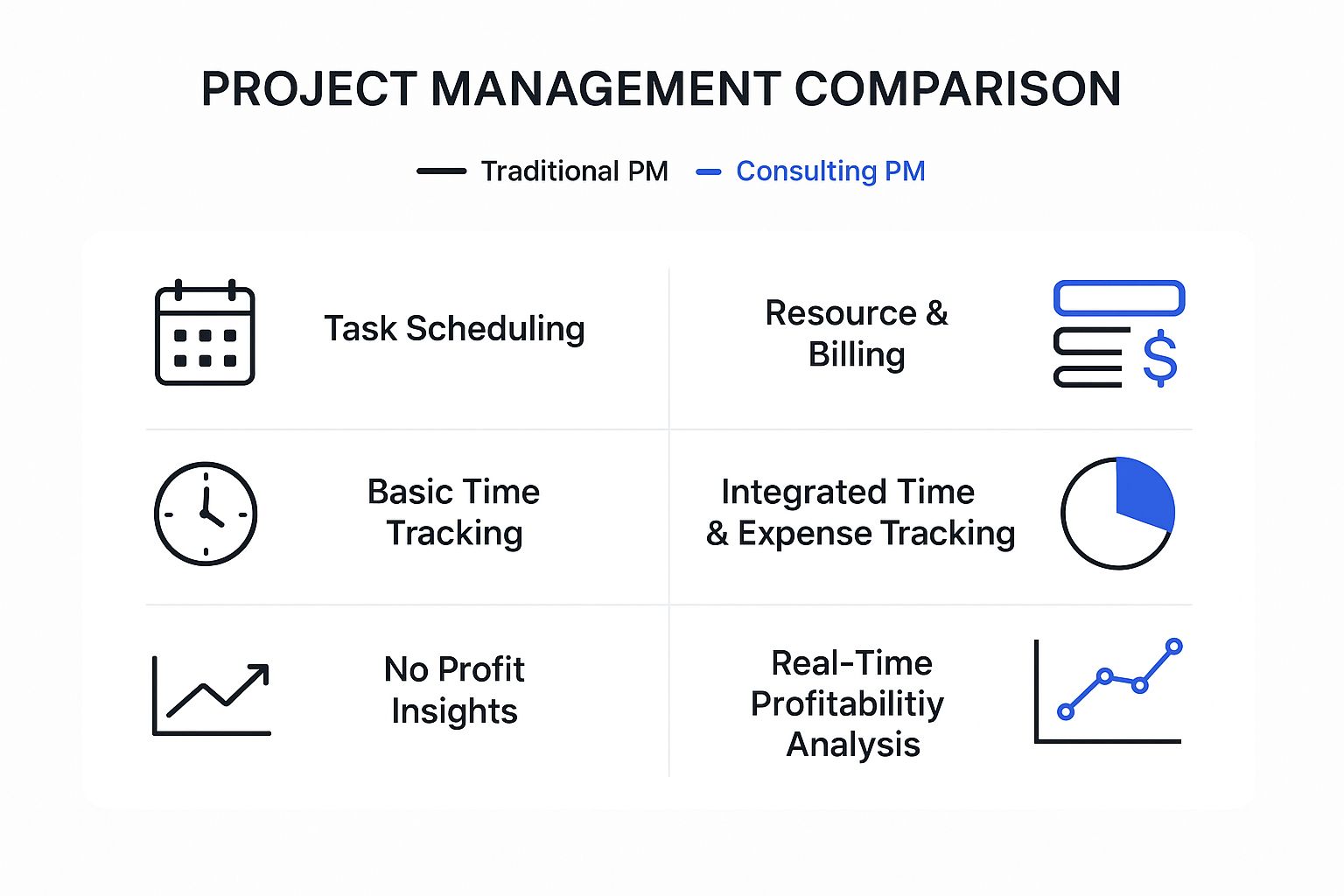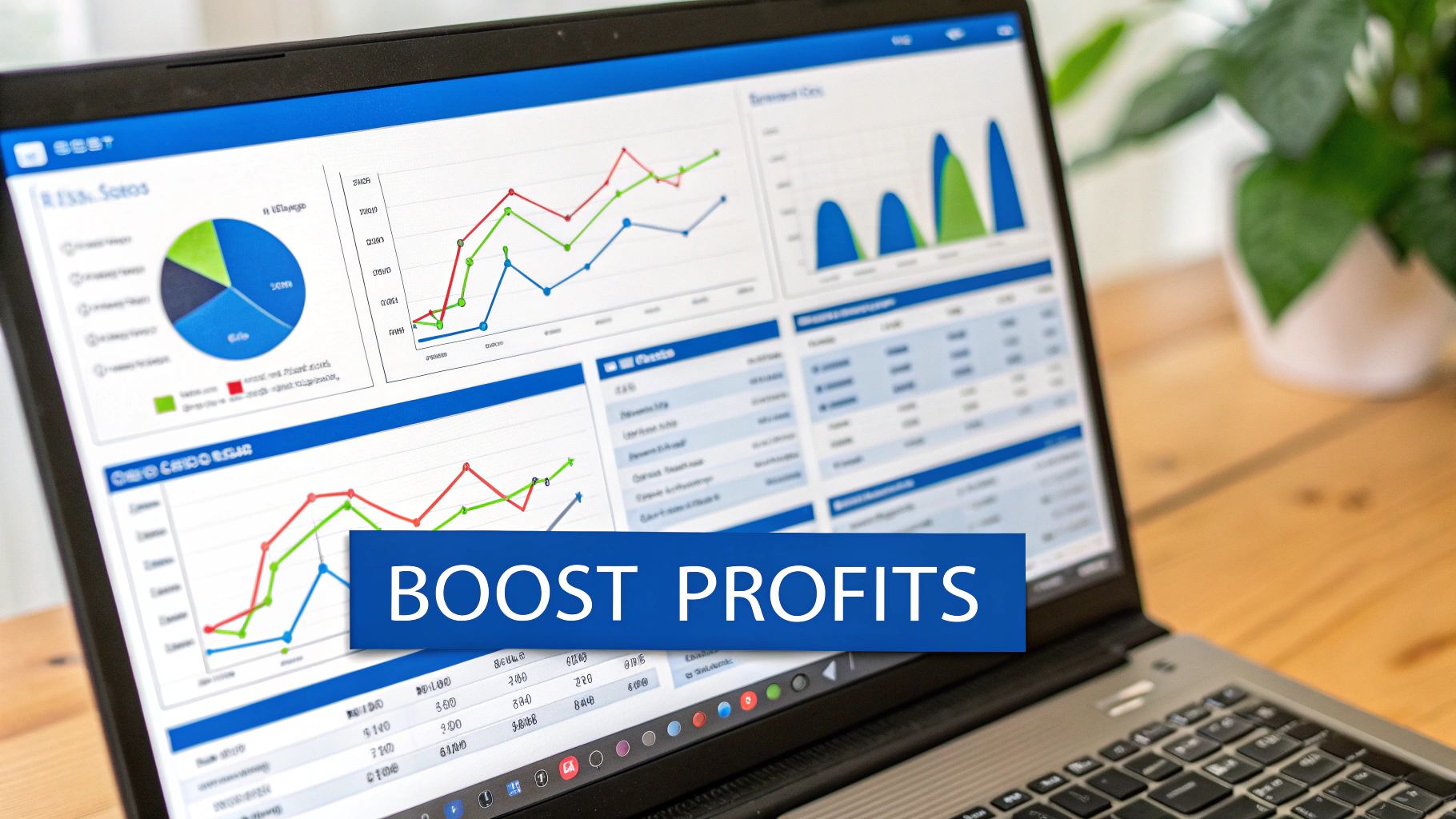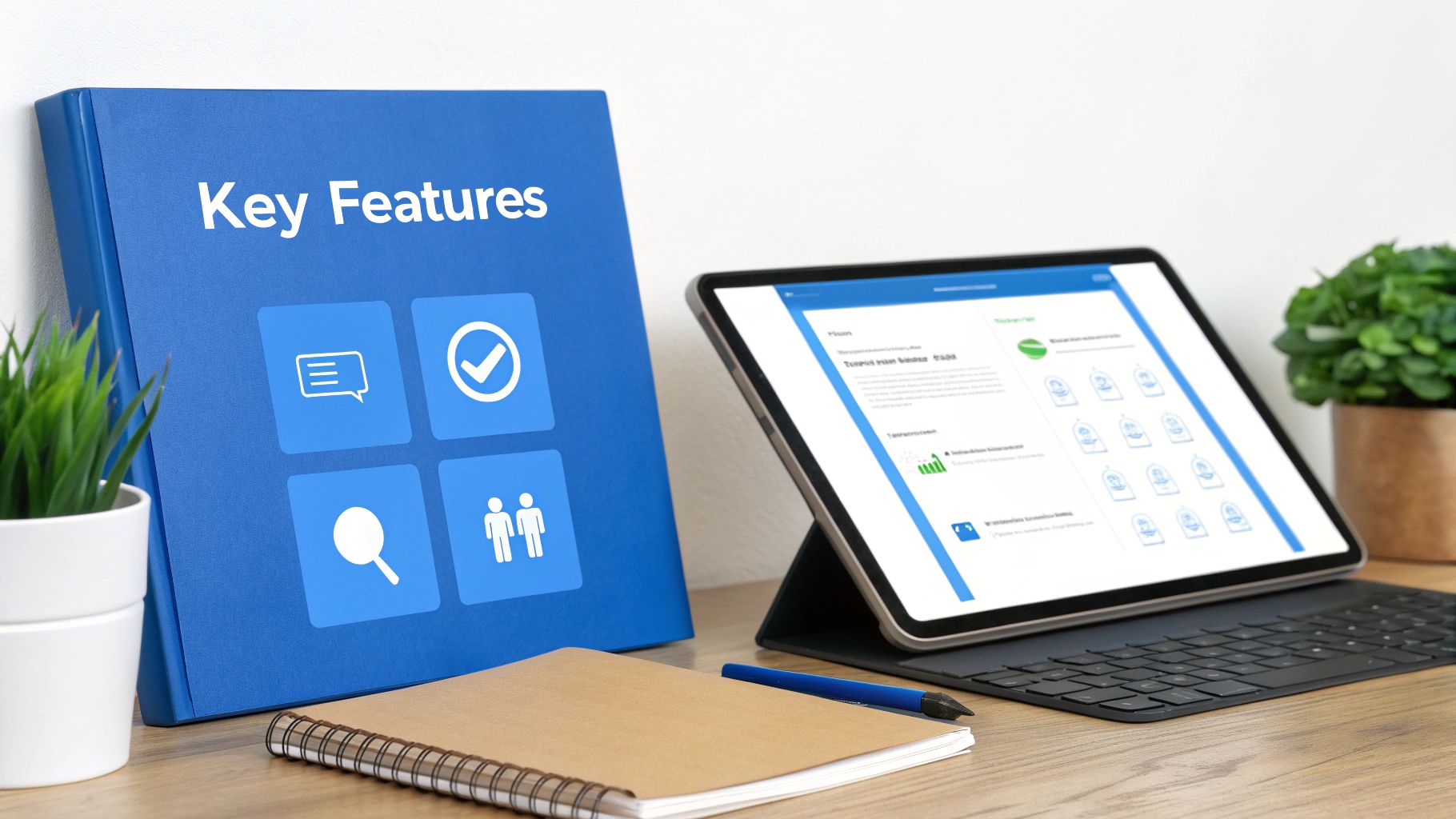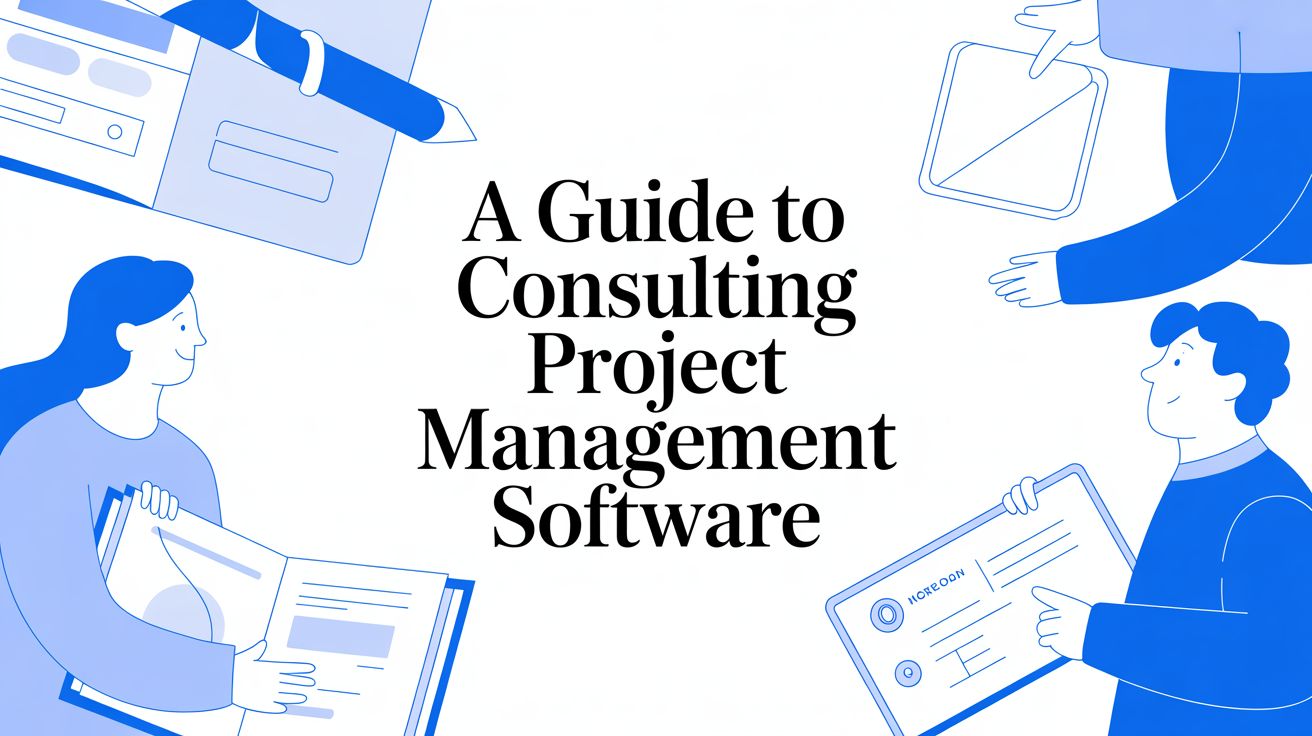- The Strategic Edge for High-Performing Consultants
- Bridging the Gap in Consulting Operations
- What Is Consulting Project Management Software
- Beyond Task Management: A Single Source of Truth
- Connecting Projects to Profitability
- Boosting Profitability with Specialized Software
- Preventing Budget Overruns Proactively
- Maximizing Resource Utilization
- Essential Features Every Consultant Needs
- Integrated Time and Expense Tracking
- Advanced Resource Planning
- Client Collaboration Portals
- Real-Time Profitability Reporting
- How to Choose the Right Software for Your Firm
- Key Factors to Consider
- Your Demo Day Checklist
- Your Blueprint for a Successful Implementation
- A Phased Approach to Success
- A Few Final Questions
- Can This Software Integrate With My Existing Tools?
- Is This Type of Software Only for Large Consulting Firms?
Let’s be real: trying to run a consulting firm on generic project management software is like trying to perform surgery with a Swiss Army knife. Sure, it has a bunch of tools, but none of them have the precision you actually need. The best consulting project management software isn’t just another tool; it’s a purpose-built asset designed to manage client expectations, track every single billable minute, and ultimately protect your profitability.
The Strategic Edge for High-Performing Consultants

In consulting, your success hinges on more than just delivering brilliant work. It’s about managing the entire client relationship—from the first call to the final invoice—with a sharp eye on the numbers. Standard project tools might help you tick off tasks, but they completely miss the mark where it really counts for a professional services firm. For instance, they can’t connect a consultant’s logged hours directly to a project’s real-time profitability or give you a bird’s-eye view of who’s swamped and who’s on the bench.
This is exactly where specialized software steps in. It’s built from the ground up to handle the messy, complex reality of client work. Think of it as the command center for your entire operation, tying all the moving parts together into one coherent system.
Bridging the Gap in Consulting Operations
Let’s be honest, generic software often creates more work than it saves. You end up juggling spreadsheets for budgets, a separate app for time tracking, and yet another system for billing. This patchwork approach is a recipe for disaster—it’s full of manual data entry, ripe for human error, and gives you a delayed, fragmented picture of how your projects are really doing.
A dedicated platform, on the other hand, gives you one version of the truth.
Imagine a team member logs their time. With a specialized system, that data instantly flows everywhere it needs to go. It updates the project budget in real-time, gives you a clearer picture of your team’s capacity for next week, and queues up that time for the next invoice. This isn’t just about making life easier; it’s about being able to make smart, proactive decisions based on what’s happening right now.
A purpose-built system doesn’t just manage tasks; it manages the business of consulting. It turns your day-to-day operational data into powerful strategic insights, helping you spot your most profitable clients, get ahead of scope creep, and make sure every project is a win for the bottom line.
By ditching basic task checklists for a true operational platform, your firm can:
- Improve Project Profitability: See at a glance which projects are on track and which are bleeding money, giving you the chance to step in and make corrections before it’s too late.
- Maximize Resource Utilization: Get a crystal-clear view of who is working on what. This helps you avoid burning out your top performers while ensuring you’re not paying for talent to sit on the sidelines.
- Enhance Client Satisfaction: Deliver accurate, on-time updates and transparent invoices. Nothing builds trust faster than clarity and professionalism.
What Is Consulting Project Management Software
At its core, consulting project management software is the operational hub for your entire firm. It’s a lot more than a fancy to-do list or a collection of task boards. Instead, you should think of it as a purpose-built operating system that ties your project delivery directly to your business operations—connecting every billable hour straight to your bottom line.
Most traditional project management tools are built to focus almost entirely on tasks, deadlines, and timelines. A specialized platform for consultants goes much, much further. It expertly blends those essential project functions with the unique financial and operational realities of a professional services business. This means it pulls in features like resource allocation, client billing, and real-time profitability tracking, all into one unified system.
Beyond Task Management: A Single Source of Truth
This seamless integration is what really sets it apart. The software becomes a single source of truth, giving you a complete, top-down view of every project’s financial health and operational status. You can finally stop piecing together information from scattered spreadsheets, separate time trackers, and different invoicing apps.
The demand for this kind of unified software is exploding. In fact, the global project management software market is forecast to nearly triple by 2035, ballooning to approximately $18.9 billion. This growth is being driven by the clear need for central platforms that can wrangle complex projects and remote teams without missing a beat.
The core idea is simple but powerful: When a consultant logs an hour, the system should instantly know what that hour means for the project’s budget, the client’s invoice, and the firm’s overall profitability.
This infographic does a great job of breaking down the key differences between a standard PM tool and one built specifically for consulting.

As you can see, the focus shifts from just managing the work to managing the business of that work. Profitability sits right at the center of every decision.
Connecting Projects to Profitability
To get a bit more technical, this kind of software is a type of Professional Services Automation (PSA) platform. These systems are specifically engineered to automate and manage the core business processes of service-based companies. By doing that, they create a clear, real-time link between the work your team delivers and the financial performance of your firm. If you’re new to the term, our guide on PSA software offers a much deeper look into how these platforms function.
By bringing every stage of a project’s lifecycle together—from the initial proposal right through to the final payment—this software gives you the power to make smarter, data-driven decisions that directly boost your bottom line and improve client satisfaction. It’s about running your firm with precision, not guesswork.
Boosting Profitability with Specialized Software

Let’s be honest, ditching a patchwork of spreadsheets and disconnected apps isn’t just about cleaning up your workflow—it’s about making more money. The real magic of consulting project management software is how it connects your team’s daily grind directly to the firm’s financial health, all in real time. This isn’t just data; it’s the kind of insight that fuels profit-boosting decisions.
Think about it this way: a junior consultant logs their hours for the week. In a typical setup, that timesheet just sits there, waiting for payroll. But in a purpose-built system? Those hours instantly update the project budget, giving you a live look at how much runway you have left before you start burning through your margin.
Preventing Budget Overruns Proactively
Scope creep and budget blowouts are the silent killers of a consulting firm’s profitability. These problems have a nasty habit of staying hidden until it’s way too late, leading to awkward client conversations or, worse, forcing you to eat a significant loss. Good software is your early-warning system.
For example, you can set an automatic alert to go off the moment a project hits 80% of its budgeted hours. That simple notification is a game-changer. It gives you a heads-up to review the remaining work, talk to the client about a change order, or shuffle resources before the project bleeds red ink. It’s all about getting ahead of the problem, not reacting to it after the fact.
By the time a project’s budget overrun appears on a month-end report, the damage is already done. Real-time visibility allows you to protect your margins while the project is still in motion, not after the fact.
This proactive approach turns what could have been a loss into an opportunity for sharper client communication and tighter project control. The result? Your firm becomes more reliable and more profitable.
Maximizing Resource Utilization
Your team is your most valuable—and most expensive—asset. Keeping them effectively utilized is absolutely fundamental to your bottom line. Smart resource management tools give you a bird’s-eye view of your entire team’s capacity, making it easy to put the right people on the right projects without driving them into the ground.
This visibility solves two classic, costly problems:
- Underutilization: Talented consultants sitting on the bench is like setting cash on fire.
- Overutilization: Burning out your top performers leads to sloppy work, unhappy clients, and, eventually, staff turnover.
Let’s say you can instantly see that a senior engineer is booked at 110% capacity for the next two weeks, while another has some breathing room. A platform that visualizes these workloads allows you to shift tasks around to keep projects moving and protect your team’s sanity.
When you link time tracking directly to invoicing, optimize how you allocate your team, and maintain crystal-clear client updates, the right software stops being a tool and becomes a core driver of your financial success. It ensures every billable hour gets captured, every project sticks to its budget, and every team member is set up to deliver their best work.
Essential Features Every Consultant Needs

When you start shopping around for software, it’s easy to get buried under a mountain of feature lists. Let’s cut through the noise. To find the right tool, you need to focus on the core functions that solve the biggest, most persistent headaches for consulting firms.
These aren’t just nice extras; they’re the absolute bedrock of a well-oiled, profitable operation. Think of the right consulting project management software less as a generic app and more like a central nervous system for your firm, connecting every single action back to a financial outcome.
Integrated Time and Expense Tracking
For any consultant, time isn’t just a resource—it’s the actual product you’re selling. That’s why a clunky, disconnected system for tracking time is a massive profit leak waiting to happen. The best platforms build this function directly into the project workflow.
This allows your team members to log hours and pop in expenses—like a client lunch or travel mileage—against specific tasks or milestones with just a few clicks. It’s a game-changer. This tight integration kills the need for manual data entry from separate apps, which not only saves time but drastically cuts down on human error. Every single billable minute gets captured.
To see just how seamless this can be, you can dive deeper into our breakdown of time tracking software for consultants.
Advanced Resource Planning
Figuring out who’s available, who’s slammed, and who has that niche skill set you need is the secret sauce to keeping both your projects profitable and your team happy. Advanced resource planning goes way beyond a simple shared calendar. It gives you a visual, firm-wide command center showing your entire team’s capacity and future commitments.
With this feature, you can finally:
- Forecast with confidence: See project demand weeks or even months out, helping you make smarter hiring decisions before you’re in a bind.
- Balance the workload: Easily spot consultants running at 110% capacity and shift tasks to those with bandwidth, preventing burnout before it starts.
- Build the A-team: Quickly find and assign the people with the exact skills needed for that new, complex project you just landed.
Client Collaboration Portals
The endless back-and-forth emails and constant “just checking in” meetings can absolutely devour your non-billable hours. A secure client portal is the antidote, giving your clients a dedicated, transparent window into how their project is progressing.
These portals are where you can share key documents, post milestone updates, and handle approvals—all in one place. It doesn’t just save you time. It elevates the entire client experience, building a foundation of trust through genuine transparency.
A great client portal transforms your relationship from a simple vendor exchange into a true partnership. It shows clients you value their involvement and are committed to keeping them in the loop every step of the way.
Real-Time Profitability Reporting
Last but definitely not least, the most powerful feature is the one that tells you if you’re actually making money. Real-time profitability reporting connects the dots between time tracking, expenses, and project budgets to give you an up-to-the-minute P&L on every single project.
This isn’t just about looking in the rearview mirror. It gives firm partners the hard data they need to make strategic calls on which types of projects are most lucrative, guiding future business development and locking in long-term success. With the global software consulting market projected to hit over $1,143 billion by 2034, this kind of financial clarity is becoming non-negotiable. You can read more about these software consulting market projections here.
How to Choose the Right Software for Your Firm
Picking the right consulting project management software is a huge decision. This isn’t just about ticking boxes on a feature list; it’s about finding a true operational partner that understands how your firm works today and where you want to take it tomorrow. The whole point is to find a system that feels like a natural extension of your team’s workflow, not another clunky app they have to wrestle with every day.
The smartest move you can make is to start by looking inward. Before you even think about booking a demo, it’s a good idea to get honest about your firm’s specific needs and, more importantly, its biggest pain points. A nimble five-person marketing agency has wildly different needs than a massive engineering firm juggling multi-year, multi-stakeholder projects.
Key Factors to Consider
Start by sizing up a few core areas. This simple step will help you build a shortlist and save you from wasting countless hours on demos for software that was never going to be the right fit.
-
Firm Size and Complexity: A five-person shop doesn’t need the same beast of a system that a 500-person enterprise does. Look for software that fits your scale right now but has a clear, sensible path for growth. Can you easily add more users or bolt on advanced features as you expand?
-
Essential Integrations: Your new platform has to play nice with the tools you already live in. Make a non-negotiable list of your current software, especially your accounting package (QuickBooks, Xero) or your CRM. If a platform can’t connect to your financial system, you’re just creating more manual work and defeating the purpose of getting a unified system in the first place.
-
Scalability for Future Growth: Dust off your five-year plan. Will the software you pick today still be able to keep up when you’ve doubled your team or branched into new service lines? You want to see flexible pricing and features that can grow right alongside you.
Don’t just buy for the firm you are today. Invest in a platform that can support the firm you’re trying to become. The right software is a long-term asset, not a temporary fix you’ll outgrow in 12 months.
Your Demo Day Checklist
Once you’ve got that shortlist, it’s demo time. This is your chance to see the software in a real-world context. Don’t let the sales rep run the show with their standard, polished presentation. You need to show up with specific, practical questions that test whether the platform can actually solve your day-to-day problems.
Here’s a practical checklist to take into your next product demo:
- Profitability Reporting: “Can you show me, step-by-step, how I’d pull a real-time profitability report for a live project? I need to see our labor costs, expenses, and revenue all in one place, right now.”
- Scope Creep Management: “Walk me through how the system handles a change order. How do I add a new deliverable and adjust the budget without completely losing the original project baseline?”
- Resource Allocation: “Let’s imagine one of my senior consultants is completely slammed. How can I see my whole team’s workload at a glance and easily move a few tasks to someone who has the bandwidth?”
- Invoicing Workflow: “Show me exactly how logged time and approved expenses get pulled onto a client invoice automatically. How much clicking and manual data entry is still involved?”
Asking pointed, scenario-based questions like these cuts right through the sales pitch. It makes the vendor prove exactly how their software will handle the jobs that actually matter to your bottom line. This changes the game from a simple feature-to-feature comparison into a real test of the platform’s value to your firm.
Your Blueprint for a Successful Implementation
You’ve made the big decision and picked your new consulting project management software. That’s a huge step, but the journey isn’t over yet. Technology is only half the battle; a successful rollout is what turns a great tool into a genuine asset for your firm.
Rushing the implementation is a classic misstep that almost always leads to low adoption and a lot of frustration. It’s helpful to think of the rollout as a strategic project in its own right. A thoughtful, phased approach ensures your team feels supported and confident, paving the way for a smooth transition and some immediate wins.
The Drum team has also created guides to enable a smooth implementation here.
A Phased Approach to Success
Whatever you do, try to avoid a “big bang” launch where everyone is thrown in at the deep end all at once. A gradual rollout minimizes disruption and builds momentum. This simple, four-step process provides a clear path to get your team onboard and realize the software’s full potential from day one.
-
Define and Streamline Processes First. Before you even touch the software, map out your existing workflows. Pinpoint the bottlenecks and areas that just aren’t working. The goal isn’t to force your old, clunky processes into a new system but to use this as an opportunity to genuinely refine how you work.
-
Start Small with a Pilot Project. Pick one or two tech-savvy teams for a pilot run on a real, but low-risk, project. This creates a safe space to learn the ropes, test integrations, and gather honest feedback without the risk of derailing a high-stakes client engagement.
-
Champion User Training and Adoption. Don’t just send a link and hope for the best. Host engaging training sessions—maybe a “lunch and learn”—and appoint a “super user” on each team. This person can act as the go-to resource for quick questions and day-to-day help.
-
Iterate Based on Team Feedback. After the pilot wraps up, get your team’s insights. What worked well? What was confusing or clunky? Use this feedback to tweak your training materials and software configuration before rolling it out to the entire firm.
Technology is a powerful enabler, but people drive success. A successful implementation focuses just as much on your team’s experience and adoption as it does on the software’s features.
By following this blueprint, you’re not just installing software; you’re building a new, more efficient operating system for your entire firm. As you refine your processes, you’ll also want to think about how this new system handles key workflows. To help with that, explore our guide on financial integration and delegation to ensure your projects and finances stay perfectly aligned.
A Few Final Questions
Still weighing your options? That’s smart. Choosing the right software is a big commitment, so let’s tackle a couple of common questions we hear from consulting firms just like yours.
Can This Software Integrate With My Existing Tools?
It absolutely should, and this is a non-negotiable. The best platforms are built to connect with the tools you already run your business on, like accounting software such as QuickBooks and Xero or your existing CRM.
This isn’t just a “nice-to-have” feature. Integration is what creates a single source of truth for your firm, killing off manual data entry and guaranteeing your project data is always in lockstep with your financial records. No more late-night data wrangling.
Is This Type of Software Only for Large Consulting Firms?
Not in the slightest. While the big players definitely rely on this kind of software, it’s become an essential tool for smaller, ambitious firms looking to punch above their weight. In fact, small businesses are 13% more likely to adopt these tools to get an efficiency edge.
The market has shifted. It’s now packed with scalable, subscription-based options that are built for the budgets and operational needs of growing firms. The U.S. collaboration and project management software market hit around $2.9 billion in 2025, a number driven by subscription models making powerful tools accessible to everyone. You can dig into more stats on the project management software market over at ibisworld.com.
The right software shouldn’t feel like an enterprise expense. It should feel like an investment in profitability that delivers a clear return, whether you have a team of five or five hundred.
Think of it as leveling the playing field. It gives your boutique firm the same operational firepower as your largest competitors.
Ready to see how a purpose-built platform can transform your firm's profitability and efficiency?
Drum unifies your entire workflow from proposal to invoice.
Start your free 14-day trial of Drum today and experience a smarter way to manage your consulting business.


